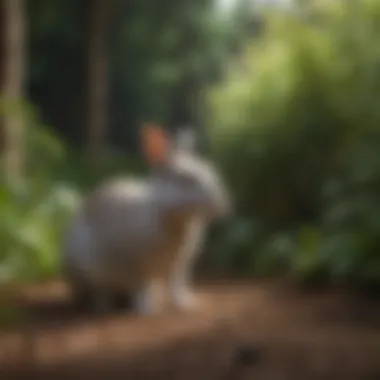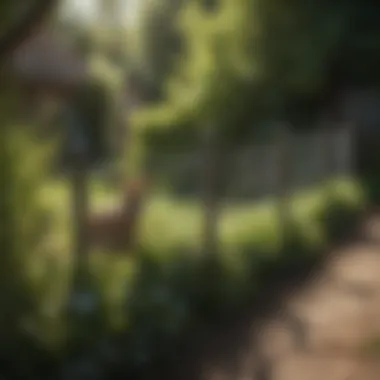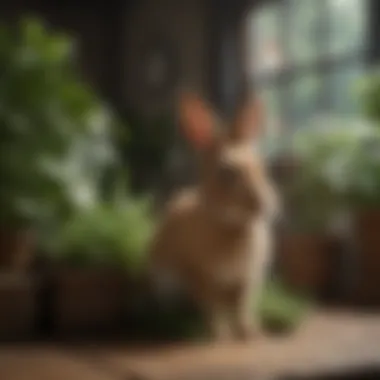Protect Your Plants: Expert Ways to Deter Rabbits


Gardening Know-How
Rabbits can be delightful creatures to observe and enjoy, but when they start munching on your beloved plants, it can quickly turn into a gardeners' nightmare. To protect your precious plants from these pesky nibblers, you need to arm yourself with the knowledge of effective methods to keep rabbits away.
Plant Selection Strategies
When planning your garden, opt for plants that are less appealing to rabbits. Consider including rabbit-resistant varieties such as lavender, Russian sage, and marigolds. These plants are less likely to attract curious bunnies, reducing the risk of damage to your garden.
Natural Repellents
Utilizing natural repellents can be a safe and eco-friendly way to deter rabbits from feasting on your plants. Ingredients like garlic, chili powder, and vinegar can be mixed to create a potent repellent spray. By applying this mixture strategically around your garden, you can create a barrier that rabbits will find unpleasant, steering them clear of your plants.
Physical Barriers
For a more hands-on approach, consider installing physical barriers around your garden. Fencing made of chicken wire or hardware cloth can be an effective deterrent against rabbits. Make sure the fence is buried sufficiently underground to prevent rabbits from burrowing underneath. Additionally, adding a layer of netting over vulnerable plants can offer extra protection from curious nibblers.
Habitat Modification
To make your garden less enticing to rabbits, aim to modify their habitat. Eliminate tall grass, brush piles, and other hiding spots near your garden that may attract rabbits. By removing these cozy shelters, you make your garden less appealing to rabbits, encouraging them to seek food elsewhere.
Deterrent Plants
Integrating rabbit-repellent plants into your garden can help ward off these intruders. Plants like daffodils, euphorbias, and foxgloves have natural toxins that rabbits avoid. By strategically placing these deterrent plants around your garden perimeter, you can create a buffer zone that deters rabbits from venturing further into your green sanctuary.
Conclusion
By implementing a combination of plant selection strategies, natural repellents, physical barriers, habitat modifications, and deterrent plants, you can effectively keep rabbits away from your plants and safeguard your garden oasis. With these proactive measures in place, you can enjoy a flourishing garden free from the threat of rabbit damage, ensuring that both your plants and furry visitors coexist harmoniously.
Understanding Rabbit Behavior
Understanding rabbit behavior is a crucial aspect of effectively keeping your plants safe from these nuisance creatures. By delving into the intricacies of rabbit behavior, you can better comprehend why they are drawn to your plants and how to deter them successfully. This section will explore various elements such as dietary preferences, shelter needs, and their need for protection from predators, providing homeowners and gardening enthusiasts with valuable insights to safeguard their gardens. Understanding these behaviors is essential for creating a strategic defense plan against rabbit damage.
What Attracts Rabbits to Your Plants?
Rabbits are attracted to plants due to their dietary preferences, seeking out specific types of vegetation that satisfy their nutritional needs. Their fondness for fresh, tender shoots and leaves makes gardens a prime target for these furry foragers. Additionally, rabbits seek shelter among plants to protect themselves from predators while also finding cover for their daily activities, including feeding and grooming. Understanding these attraction factors is key to implementing effective deterrent strategies.


Dietary Preferences
Rabbits have a voracious appetite for a wide range of plants, with an emphasis on tender shoots, leafy greens, and certain vegetables. Their preference for fresh, succulent vegetation heightens the risk of plant damage in gardens, prompting the need for protective measures. By grasping their dietary inclinations, homeowners can select plant varieties that are less appealing to rabbits, reducing the likelihood of extensive damage.
Shelter Needs
Rabbits rely on plants for shelter and protection, using dense foliage and bushes as hiding spots from potential threats. By understanding their shelter requirements, homeowners can strategically design their garden layout to minimize hiding spots and potential rabbit habitats. Creating an environment that is less conducive to rabbit habitation can deter these pests and safeguard your plants.
Protection from Predators
In the wild, rabbits are vulnerable to various predators, driving them to seek refuge in gardens that provide cover from looming dangers. By addressing their need for protection, homeowners can introduce measures such as deterrent scents or barriers that simulate predator presence, deterring rabbits from lingering in the area. Implementing protective strategies can disrupt the rabbits' sense of security, encouraging them to seek alternative habitats away from your plants.
Identifying Signs of Rabbit Damage
Detecting signs of rabbit damage is crucial for early intervention to prevent extensive harm to your plants. Common indicators include browsing on leaves, nibbling on stems, and the destruction of flowers, revealing the presence of these garden pests. By recognizing these telltale signs, homeowners can swiftly implement protective measures to deter rabbits and safeguard their garden's integrity.
Natural Deterrents
Natural deterrents play a crucial role in protecting your plants from potential rabbit damage. By incorporating these methods, you can effectively ward off rabbits without causing harm to them. Implementing natural deterrents not only safeguards your garden but also promotes a safe and healthy environment for both plants and animals. With a focus on sustainability and eco-friendliness, natural deterrents offer a long-term solution to keeping rabbits at bay.
Planting Rabbit-Repellent Vegetation
When it comes to planting rabbit-repellent vegetation, options like lavender, marigolds, and geraniums can serve as effective choices. These plants not only add beauty to your garden but also serve the practical purpose of repelling rabbits naturally. Their strong scents and unappealing taste make them undesirable targets for rabbits, effectively protecting your other plants and flowers from potential damage. By strategically incorporating these plants into your garden, you can create a protective barrier that is both aesthetic and functional.
Lavender
Lavender, known for its fragrant flowers and calming properties, acts as a potent rabbit deterrent due to its strong scent. This aromatic herb not only adds a delightful fragrance to your garden but also serves as a natural barrier against rabbit intrusion. Its low maintenance requirements and ability to thrive in various climates make it a practical choice for gardeners looking to ward off rabbits effectively.
Marigolds
Marigolds, with their vibrant blooms and natural pest-repelling properties, offer a dual benefit for your garden. These colorful flowers not only brighten up your outdoor space but also act as a natural deterrent against rabbits. Their pungent odor and bitter taste make them an unattractive option for rabbits, effectively protecting your plants from potential harm.
Geraniums
Geraniums, known for their visually appealing flowers and versatility in garden settings, serve as another effective rabbit-repellent option. Their strong fragrance and repellent properties make them a popular choice for gardeners seeking natural ways to deter rabbits. With a wide range of colors and varieties available, geraniums can easily blend into different garden aesthetics while providing essential protection against rabbit damage.
Creating Physical Barriers


In addition to planting rabbit-repellent vegetation, creating physical barriers is another effective method to keep rabbits away from your plants. Fencing, chicken wire, and netting are practical options that offer a physical barrier against rabbit intrusion, preventing them from accessing your garden and causing damage. These barriers not only serve as a visual deterrent but also provide a tangible defense mechanism to safeguard your plants from rabbit interference.
Fencing
Fencing is a robust solution for keeping rabbits out of your garden. By installing a sturdy fence around your property, you can prevent rabbits from entering and protect your plants from potential harm. Opt for fences with small gaps to ensure rabbits cannot squeeze through, and secure the bottom of the fence to prevent burrowing attempts. With various fencing materials and styles available, you can choose a design that complements your garden while providing optimal protection.
Chicken Wire
Chicken wire offers a versatile and cost-effective option for creating physical barriers against rabbits. This flexible mesh fencing can be easily installed around vulnerable areas of your garden to deter rabbit entry. Its durable construction and ability to conform to different shapes make it a practical choice for protecting specific plants or landscaping features from rabbit damage. By strategically positioning chicken wire around your garden, you can effectively minimize the risk of rabbit infestations.
Netting
Netting serves as a lightweight yet effective barrier against rabbits, especially for protecting individual plants or crops. By covering vulnerable plants with netting, you can prevent rabbits from accessing them while allowing sunlight and water to reach the vegetation. Choose netting with small gaps to ensure rabbits cannot chew through or get entangled in the material. With proper installation and maintenance, netting can be a reliable and unobtrusive way to protect your plants from rabbit interference.
Utilizing Scents and Odors
Incorporating scents and odors that are unpleasant to rabbits can also help deter these pests from your garden. Garlic and onion sprays, pepper flakes, and essential oils are common options that exploit rabbits' sensitive olfactory senses to discourage their presence. These natural deterrents not only repel rabbits but also add a pleasant aroma to your garden, enhancing the overall sensory experience while safeguarding your plants.
Garlic and Onion Sprays
Garlic and onion sprays contain compounds that emit strong odors detested by rabbits, making them effective natural repellents. By spraying these solutions around your garden or near vulnerable plants, you can create a protective barrier that deters rabbits from approaching. The pungent scent of garlic and onions acts as a powerful deterrent without causing harm to the environment or other wildlife, offering a safe and non-toxic method of rabbit control.
Pepper Flakes
Pepper flakes, known for their spicy and pungent aroma, can also help repel rabbits from your garden. Sprinkling pepper flakes around plant beds or infested areas creates an unpleasant barrier that rabbits are likely to avoid. The fiery nature of pepper flakes effectively discourages rabbits from nibbling on your plants, providing a simple yet natural deterrent against unwanted pests.
Essential Oils
Essential oils, such as peppermint, citronella, and eucalyptus, have strong scents that rabbits find unappealing. By diffusing these essential oils in your garden or creating homemade sprays, you can create an aromatic shield that deters rabbits from causing damage to your plants. The pleasant fragrances of essential oils not only mask the appealing scents of your garden but also discourage rabbit foraging, providing an eco-friendly and sustainable approach to rabbit repellent methods.
Humane Repellent Methods
In this article, the focus is on humane repellent methods to keep rabbits away from your plants. It is crucial to address this topic with care and consideration for the animals while effectively protecting your garden. By employing humane repellent techniques, you can deter rabbits without causing harm or distress. These methods aim to create a safe environment for both your plants and the wildlife in your garden. Considering the balance between safeguarding your plants and respecting nature, humane repellent methods play a vital role in maintaining a harmonious garden ecosystem.
Motion-Activated Sprinklers


Exploring the motion-activated sprinklers as a humane repellent method in deterring rabbits is essential for effective plant protection. These sprinklers operate based on motion sensors, emitting bursts of water when detecting movement. The key characteristic of motion-activated sprinklers lies in their ability to startle rabbits away from the protected area without causing any harm. This non-lethal approach helps in maintaining the integrity of your garden while ensuring that rabbits are deterred from causing damage. The unique feature of motion-activated sprinklers is the element of surprise it offers, which disrupts rabbit behavior patterns and discourages them from frequenting your plants. While these sprinklers are effective in deterring rabbits, it is important to consider their placement and sensitivity settings to maximize their efficiency in protecting your garden.
Ultrasonic Devices
Examining the use of ultrasonic devices to impact rabbit behavior within the context of plant protection presents a sophisticated approach. Ultrasonic devices emit high-frequency sounds that are unpleasant for rabbits, encouraging them to avoid the area without physical harm. The key characteristic of ultrasonic devices is their ability to create an environment that rabbits find unfavorable, prompting them to seek alternative locations for foraging. This method is chosen for its non-intrusive nature and effectiveness in deterring pests. A unique feature of ultrasonic devices is their ability to target specific pests like rabbits while being safe for other wildlife and pets. However, one drawback of ultrasonic devices is that they may not be as effective in outdoor settings with extensive foliage or harsh weather conditions.
Beneficial Predator Introduction
Introducing beneficial predators as a natural approach to deterring rabbits can be a strategic method for plant protection. Attracting natural predators such as owls, hawks, or foxes to your garden can create a natural deterrent for rabbits. The key characteristic of this approach is the ecological balance it maintains by allowing predators to control rabbit populations naturally. This method is popular among gardeners looking for sustainable pest control solutions. A unique feature of beneficial predator introduction is its long-term effects on rabbit behavior, as the presence of predators instills a sense of risk that deters rabbits from frequenting the area. However, one disadvantage of this method is the potential disruption to the ecosystem if predator populations grow unchecked, requiring careful consideration and monitoring for successful implementation.
Maintenance and Prevention Strategies
When striving to fend off pesky rabbits from wreaking havoc on your beloved plants, the implementation of effective maintenance and prevention strategies stands paramount. By diligently adhering to these strategies, not only can you shield your garden from potential rabbit damage, but also nurture a flourishing landscape. A meticulous approach to garden upkeep is vital in safeguarding your plants against the voracious appetites of these furry intruders.
Regular Garden Inspection
Identifying potential rabbit entry points
The keen observation and identification of potential rabbit entry points play a pivotal role in fortifying your garden's defenses. By strategically pinpointing these vulnerable spots where rabbits might infiltrate, you can proactively take measures to thwart their access. Regular surveilling and analysis of these entry points aids in preemptively securing your garden from unwanted fur-based trespassers. This segment of garden inspection is crucial in formulating an airtight defense mechanism against rabbit intrusion.
Checking for signs of rabbit activity
Vigilantly monitoring and evaluating signs of rabbit activity within your garden is indispensable for early detection and intervention. By discerning telltale indications of rabbit presence, such as nibbled leaves or trampled foliage, you equip yourself with the knowledge needed to counteract their destructive tendencies effectively. Periodic checks for these evident rabbit traces enable you to promptly address any potential threats, thereby safeguarding your plants with proactive measures.
Proper Garden Cleanup
Removing excess debris
The meticulous removal of excess debris within your garden environment serves as a foundational pillar of effective rabbit deterrence. Clearing away any unnecessary clutter not only enhances the aesthetic appeal of your garden but also eliminates potential hiding spots for these mischievous intruders. By maintaining a clutter-free landscape, you create a less hospitable environment for rabbits, diminishing their attraction to your plants and reducing the likelihood of damage.
Limiting hiding spots
Strategically limiting hiding spots throughout your garden plays a significant role in discouraging rabbits from taking refuge and causing mayhem. By minimizing available hiding areas, you obstruct rabbits' ability to conceal themselves while contemplating their next botanical snack. This tactical approach disrupts their comfort zones, compelling them to seek greener pastures elsewhere, thus safeguarding your plants through the attenuation of rabbit-friendly hideaways.
Encouraging Natural Repellents
Introducing rabbit-discouraging plants
The incorporation of rabbit-discouraging plants into your garden repertoire acts as a natural deterrent against potential rabbit incursions. By strategically planting flora that rabbits find unappetizing or repulsive, you create a protective shield around your cherished plants. These repellent plants serve as a botanical barrier, dissuading rabbits from indulging in your garden delights and redirecting their foraging efforts towards more agreeable vegetation. Thus, by fostering a plant selection that repels rabbits, you fortify your garden's defenses with natural deterrents.
Maintaining a diverse garden ecosystem
The maintenance of a diverse garden ecosystem not only promotes biodiversity but also aids in deterring rabbits from targeting specific plant species. By cultivating a varied array of flora within your garden, you introduce complexity and unpredictability into the rabbit's foraging landscape. This diverse ecosystem confounds rabbits by offering a smorgasbord of plant choices, making it less predictable and less enticing for them to feast on any one particular species. Embracing a diverse garden ecosystem thus serves as a strategic defense mechanism, safeguarding your plants through the cultivation of botanical diversity.







